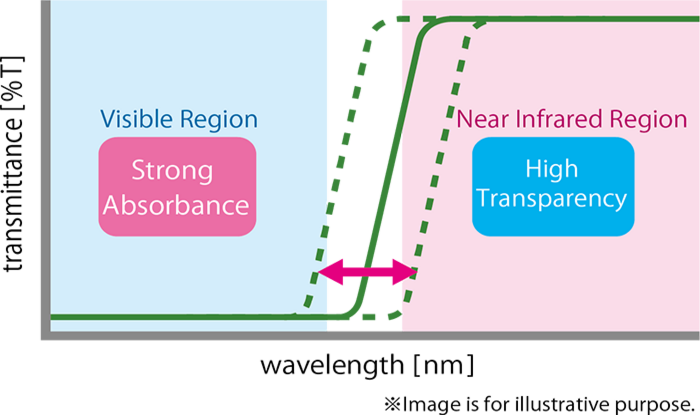Near-infrared transmissive materials

- What are NIR transmissive materials?
- Characteristics of NIR transmissive materials
- Uses of NIR transmissive materials
- Transmission spectra of NIR transmissive materials
- Application of NIR transmissive materials
What are NIR transmissive materials?
Our NIR (Near-infrared rays) transmissive materials can efficiently absorb visible light while realizing a high transmission of IR.
- Developed using our display color resist technology
- Can be provided as resist inks, dispersions, masterbatches, screen inks, etc.
Characteristics of NIR transmissive materials
- >90% transmittance in the near-infrared region, and <1% transmittance in the visible region
- Rising edge of the spectrum can be adjusted according to our customer's requests
Uses of NIR transmissive materials
These are some of the possible uses.

- Vehicle Installation: LiDAR sensors
- Biometric authentication: Iris recognition, Finger vein recognition, etc.
- Security cameras, 3D sensors, ToF sensors, etc.
If your interests are in any other applications, please do not hesitate to contact us.
Transmission spectra of NIR transmissive materials
Shown below is a simple illustration of what the spectrum of our NIR transmissive material would look like. The transmittance can be controlled by the amount of additives or coating thickness. We can also adjust the spectrum edge to fit our customers' needs.

Application of NIR transmissive materials
Resist inks

NIR transmissive resist ink (above), coated on a glass substrate (below)

Also compatible with screen ink.
Ideal for black mask applications in various housings such as glass and PET.
Printed materials of NIR-transmissive-ink using screen press with 270 mesh/inch, 1shot and its optical performances

| Film thickness/OD value | 10μm/2.0 |
|---|---|
| L* /a*/ b* | 6.92 / 1.60 / -1.97 |
| Surface resistance | 1.3 x 1012Ω/sq |
Inquiries
TOYO VISUAL SOLUTIONS CO., LTD.
TEL:+81-3-3272-3457
